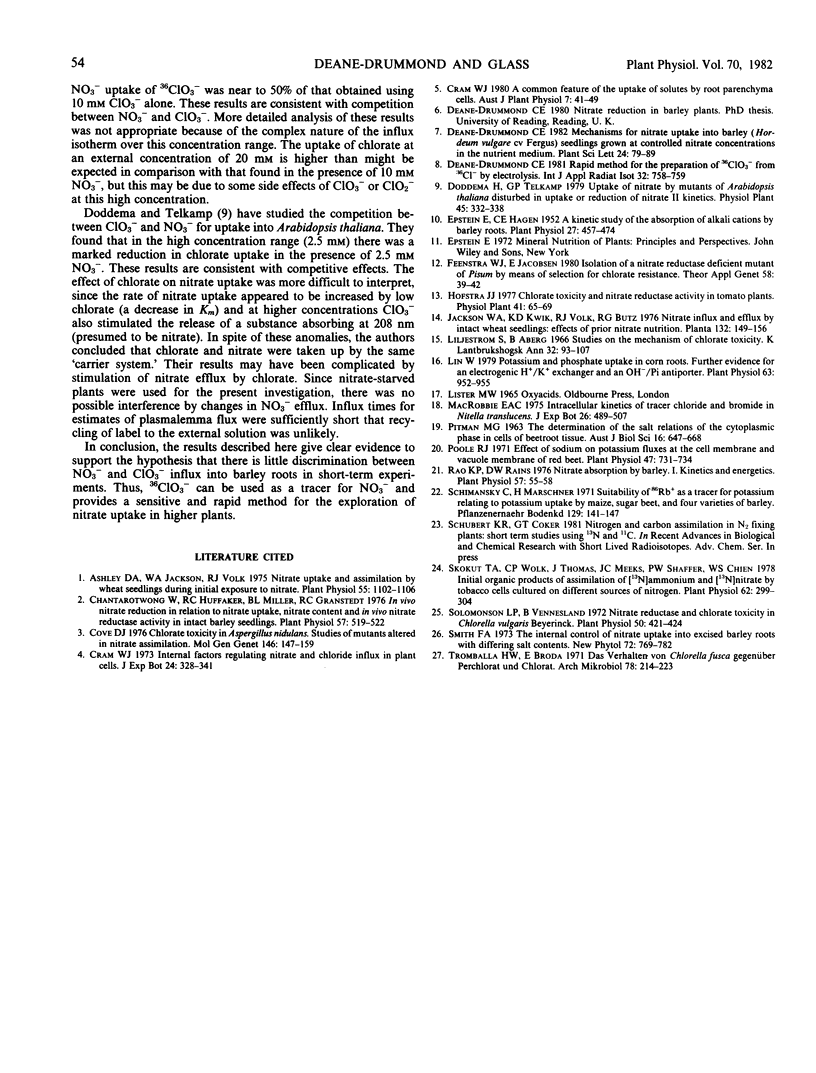Abstract
Evidence is presented that chlorate is an extremely good analog for nitrate during nitrate uptake by intact barley (Hordeum vulgare cv. Fergus) roots. The depletion of ClO3− or NO3− from uptake media over 2 to 6 hours by seedlings was found to be dependent on combined NO3− plus ClO3− concentrations, and total anion uptake was equivalent at different NO3−/ClO3− ratios. After loading barley seedlings with 36ClO3− for 6 hours, kinetic parameters were derived from the analysis of efflux of [36Cl] chlorate into unlabeled solution. On the basis of this analysis, the half times for exchange for the cytoplasmic and vacuolar phases were 17 minutes and 20 hours, respectively.
Data pooled from a number of different experiments were used to calculate kinetic constants (Km and Vmax) for 36ClO3− influx into barley roots at different external ClO3−/NO3− ratios, using short (10 minutes) influx times. There appeared to be no discrimination by the root cells between ClO3− and NO3−. Lineweaver-Burk analysis of the interaction between nitrate and chlorate were characteristic of competitive inhibition at low nitrate concentrations (0-0.5 mm). At higher concentrations, in the range of >1 mm, similar interactions between these ions were evident.
Full text
PDF




Selected References
These references are in PubMed. This may not be the complete list of references from this article.
- Ashley D. A., Jackson W. A., Volk R. J. Nitrate Uptake and Assimilation by Wheat Seedlings during Initial Exposure to Nitrate. Plant Physiol. 1975 Jun;55(6):1102–1106. doi: 10.1104/pp.55.6.1102. [DOI] [PMC free article] [PubMed] [Google Scholar]
- Chantarotwong W., Huffaker R. C., Miller B. L., Granstedt R. C. In vivo nitrate reduction in relation to nitrate uptake, nitrate content, and in vitro nitrate reductase activity in intact barley seedlings. Plant Physiol. 1976 Apr;57(4):519–522. doi: 10.1104/pp.57.4.519. [DOI] [PMC free article] [PubMed] [Google Scholar]
- Cove D. J. Chlorate toxicity in Aspergillus nidulans. Studies of mutants altered in nitrate assimilation. Mol Gen Genet. 1976 Jul 23;146(2):147–159. doi: 10.1007/BF00268083. [DOI] [PubMed] [Google Scholar]
- Epstein E., Hagen C. E. A KINETIC STUDY OF THE ABSORPTION OF ALKALI CATIONS BY BARLEY ROOTS. Plant Physiol. 1952 Jul;27(3):457–474. doi: 10.1104/pp.27.3.457. [DOI] [PMC free article] [PubMed] [Google Scholar]
- Lin W. Potassium and Phosphate Uptake in Corn Roots: Further Evidence for an Electrogenic H/K Exchanger and an OH/Pi Antiporter. Plant Physiol. 1979 May;63(5):952–955. doi: 10.1104/pp.63.5.952. [DOI] [PMC free article] [PubMed] [Google Scholar]
- Poole R. J. Effect of sodium on potassium fluxes at the cell membrane and vacuole membrane of red beet. Plant Physiol. 1971 Jun;47(6):731–734. doi: 10.1104/pp.47.6.731. [DOI] [PMC free article] [PubMed] [Google Scholar]
- Rao K. P., Rains D. W. Nitrate absorption by barley: I. Kinetics and energetics. Plant Physiol. 1976 Jan;57(1):55–58. doi: 10.1104/pp.57.1.55. [DOI] [PMC free article] [PubMed] [Google Scholar]
- Skokut T. A., Wolk C. P., Thomas J., Meeks J. C., Shaffer P. W. Initial organic products of assimilation of [N]ammonium and [N]nitrate by tobacco cells cultured on different sources of nitrogen. Plant Physiol. 1978 Aug;62(2):299–304. doi: 10.1104/pp.62.2.299. [DOI] [PMC free article] [PubMed] [Google Scholar]
- Solomonson L. P., Vennesland B. Nitrate Reductase and Chlorate Toxicity in Chlorella vulgaris Beijerinck. Plant Physiol. 1972 Oct;50(4):421–424. doi: 10.1104/pp.50.4.421. [DOI] [PMC free article] [PubMed] [Google Scholar]


